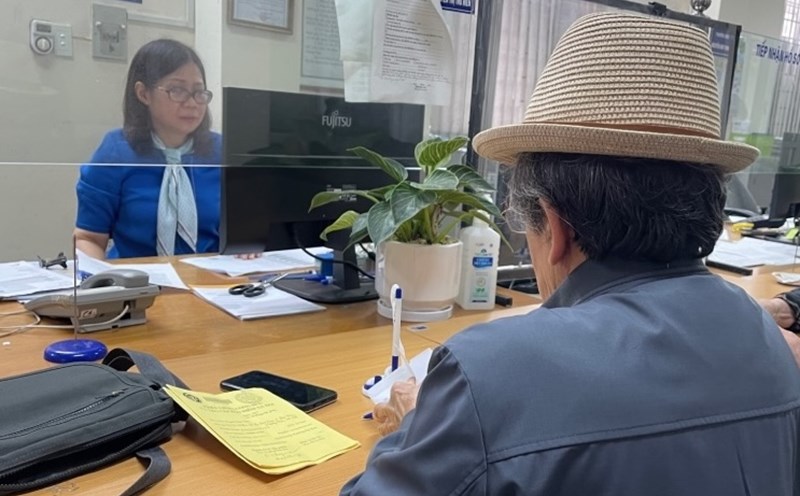On May 17, Lao Dong Newspaper in collaboration with the Hanoi Industry and Trade Trade Union organized a direct dialogue - online exchange - policy communication in 2025 with the theme: "New points on social insurance and occupational safety and hygiene".
The direct dialogue, online exchange with the theme: "New points on social insurance and occupational safety and sanitation" are valuable opportunities for officials, union members, workers, officials and employees (employees) to be updated and equipped with useful knowledge related to the salary, social insurance, labor safety and hygiene regime necessary for themselves in the process of labor deployment and participation in labor relations.
The dialogue and exchange was attended by nearly 300 union officials and employees of the Hanoi Industry and Trade sector. Participating in answering questions from officials and employees were Dr. Nguyen Huy Khoa - Deputy Head of the Faculty of Law, Trade Union University, Vietnam General Confederation of Labor Lawyers Association; Dr. Do Thi Lan Chi - Deputy Head of the Faculty of Labor Safety and Occupational Health, Trade Union University; Lawyer Dang Van Thanh - Hanoi Bar Association.
Speaking at the exchange, Deputy Editor-in-Chief of the Capital Labor Newspaper Dinh Tuan Anh said that Social Insurance and Occupational Safety and Hygiene (OSH) are not only support policies but also a foundation to ensure the life, health, stability and sustainable development of workers.
The amendments and supplements to the current social insurance policy are aimed at expanding the scope of participants, improving benefits, and at the same time creating more favorable conditions for employees to access the policies. This is a step forward to help workers and laborers feel secure in their contributions and have long-term protection, especially in difficult situations such as illness, maternity, work accidents or retirement.
New regulations on labor safety focus on raising awareness of accident prevention, improving working conditions and enhancing the responsibility of enterprises in ensuring a safe and healthy working environment.
However, for these policies to truly come into practice, not only compliance from management agencies and businesses is needed but also the proactiveness of workers in protecting themselves.
Today's dialogue is an opportunity for employees to directly ask questions and share difficulties in the process of implementing these policies. Each opinion is not only meaningful to individuals but also helps perfect the mechanism, creating conditions for the working community to have a safer, fairer and more sustainable working environment, emphasized the Deputy Editor-in-Chief of the Capital Labor Newspaper.

At the exchange, Mr. Tran Cong Hoan wondered why there is a different way of calculating pensions between the public sector and the business sector?
Dr. Nguyen Huy Khoa - Deputy Head of the Faculty of Law, Trade Union University, Vietnam General Confederation of Labor Lawyers Association answered, the pension regime is one of the social security policies for the elderly. However, there is currently a difference in pension calculation between the state and enterprise sectors, stemming from the characteristics of each sector.
Specifically, in the state sector, basic salary often increases according to seniority and coefficient. Meanwhile, in the enterprise sector, wages are mainly calculated based on labor productivity and efficiency. Therefore, if pensions are calculated based on the last few years of working time, some people may benefit, but many others will suffer more, especially when their real income is unstable.
For employees working according to the state salary table, the pension calculation depends on the time of starting to participate in social insurance. Specifically as follows:
- Before 1995: Calculating the average monthly salary for social insurance contributions of the last 5 years before retirement.
- From 1995 to the end of 2000: Average of the last 6 years.
- From 2001 to the end of 2006: Average of the last 8 years.
- From 2007 to the end of 2015: Average of the last 10 years.
- From 2016 to the end of 2019: Average of the last 15 years.
- From 2020 to the end of 2024: Average of the last 20 years.
- From 2025 onwards: Calculating the average total social insurance payment period.
For employees working in private enterprises, the pension calculation will be similar from 2025, that is, calculated according to the average of the entire time participating in social insurance.
"Accordingly, through the law amendments, it can be seen that the general trend is to move towards synchronization between the State sector and the non-State sector in the way of paying and receiving social insurance, to ensure fairness, transparency and sustainability for the social security system..." - Mr. Khoa shared.











